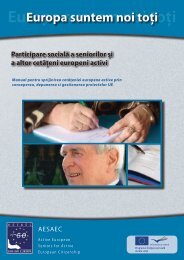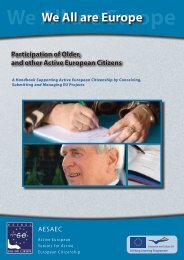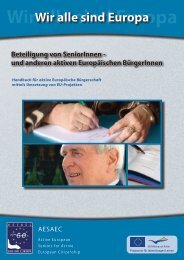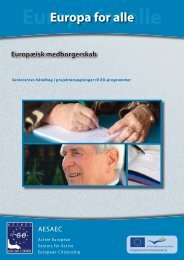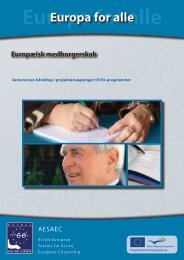We All are Europe - AESAEC
We All are Europe - AESAEC
We All are Europe - AESAEC
Create successful ePaper yourself
Turn your PDF publications into a flip-book with our unique Google optimized e-Paper software.
Module 1 – The <strong>Europe</strong>an Union and its Relevance for Senior Citizens<br />
projects, etc. Have you ever heard of Leonardo da Vinci, Grundtvig, Erasmus, Comenius and other<br />
programmes They offer frameworks within which <strong>Europe</strong>an projects as well as transactions and<br />
mutual cultural, social, economic and political exchange and mutual recognition <strong>are</strong> possible.<br />
The Nonfictional Theory, developed by Ernst Haas and Jean Monet, involves common action leading<br />
to a cohesive society. Robert Schumann said on 9 May 1950: “<strong>Europe</strong> will be built by concrete<br />
achievements which create a de facto solidarity”.<br />
Economic integration was intended to gradually build solidarity amongst the participating nations<br />
and would in turn create a need for supranational institutional laws. Later on this would lead to the<br />
need for an effective supranational structure. This theory makes us think of the “customary law”<br />
that was often created spontaneously and applied in the development of towns. Laws were not imposed<br />
on the inhabitants; rather they were a codification of the generally accepted ways of living<br />
together in a town.<br />
The integration processes step by step<br />
If we wanted to give more sense to <strong>Europe</strong>, we should first ask ourselves what <strong>Europe</strong> has become<br />
over the four stages of its integration: Customs Union, Common Market, Economic and Monetary<br />
Union and Towards Political Union. In fact, in order to understand the <strong>Europe</strong>an Union, we should<br />
not forget its past. <strong>Europe</strong> was established under much different conditions than exist today; the<br />
<strong>Europe</strong> of six member states in the early 1950s and the <strong>Europe</strong> of 27 member states in 2009 <strong>are</strong> two<br />
completely different entities.<br />
The construction of modern <strong>Europe</strong> began after the Second World War. In 1945 Winston Churchill<br />
described <strong>Europe</strong> as “a breeding ground for pestilence and hate” and a year later, as a remedy to<br />
this state, he proposed to “recreate the <strong>Europe</strong>an family and to provide it with a structure within<br />
which it can dwell in peace, safety and freedom.” Safety and freedom were the reasons why the EU<br />
was created. The successful formula was the integration of the former antagonistic nation states<br />
into a union of peacefully interacting and competing nations. In his famous appeal, Robert Schuman<br />
recognised that only a lasting reconciliation with Germany could form the basis for a united <strong>Europe</strong><br />
and he pleaded that <strong>Europe</strong> should pardon Germany, though not forget what had taken place, which<br />
at that time was a difficult thing to ask for.<br />
The process of <strong>Europe</strong>an integration has been ongoing since 1950<br />
based on the construction method taught by Jean Monnet and<br />
Robert Schuman; building <strong>Europe</strong> brick by brick, with each step<br />
being taken after c<strong>are</strong>ful evaluation.<br />
Jean Monnet contributed to the creation of the binding formula.<br />
This formula consists of creating numerous links between the nation<br />
states; common laws, policies and institutions, common <strong>Europe</strong>an<br />
method governing the member states’ economic activities that<br />
then should influence the day to day lives of <strong>Europe</strong>an citizens.<br />
Robert Schumann<br />
At the beginning the objective was for the EU to become a political<br />
structure. However this intention has failed and instead of being a<br />
strong political force <strong>Europe</strong> has became more interested in its<br />
economic power. (Jacques Delores, Les Controversies du progrès,<br />
26 th June, 2009, France Culture.)<br />
To join the <strong>Europe</strong>an Union, a state must fulfil certain economic and political conditions, called the<br />
Copenhagen Criteria (after the Copenhagen Summit in June 1993). These state that a candidate<br />
country must be a democracy, it should have a free market and should be willing to adopt the entire<br />
body of laws that the <strong>Europe</strong>an Union has already adopted. According to the Maastricht Treaty,<br />
each current member state and the <strong>Europe</strong>an Parliament must agree to any enlargement.<br />
33




